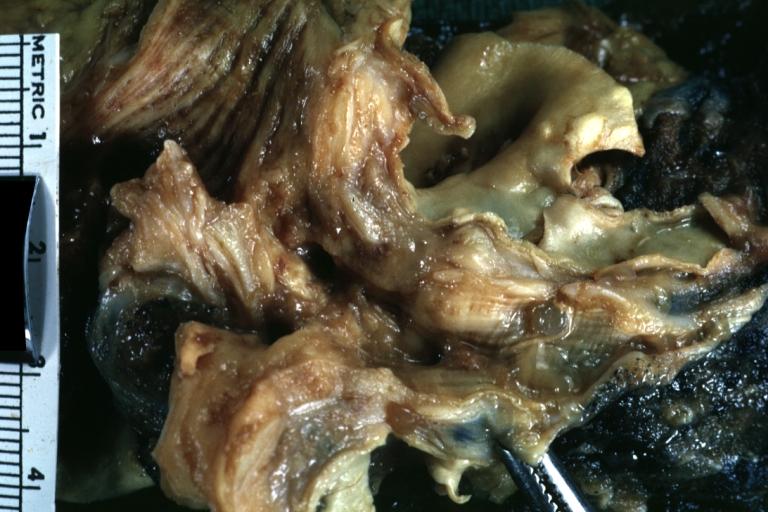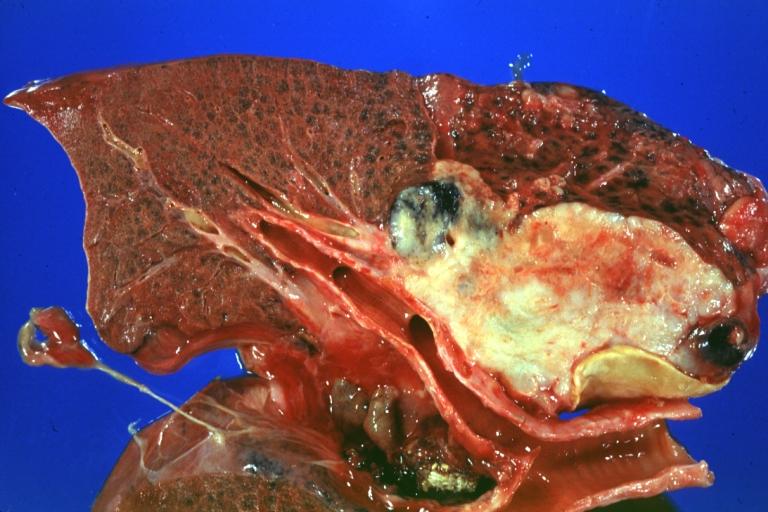Small cell carcinoma of the lung pathophysiology: Difference between revisions
| Line 87: | Line 87: | ||
==Gross Pathology== | ==Gross Pathology== | ||
The tumor cells are small and round, but sometimes can be ovoid or spindle shaped. They have a scant [[cytoplasm]] with a high mitotic count and a hyperchromatic [[nuclei]]. Nearly all SCLC are immunoreactive for [[keratin]], [[thyroid transcription factor 1]], and epithelial membrane antigen. Neuroendocrine and neural differentiation result in the expression of dopa decarboxylase, calcitonin, neuron-specific enolase, chromogranin A, CD56 (also known as nucleosomal histone kinase 1 or neural-cell adhesion molecule), gastrin-releasing peptide, and insulin-like growth factor 1. One or more markers of neuroendocrine differentiation can be found in approximately 75% of SCLC | |||
[http://www.peir.net Images courtesy of Professor Peter Anderson DVM PhD and published with permission © PEIR, University of Alabama at Birmingham, Department of Pathology] | [http://www.peir.net Images courtesy of Professor Peter Anderson DVM PhD and published with permission © PEIR, University of Alabama at Birmingham, Department of Pathology] | ||
Revision as of 20:13, 9 June 2014
|
Small Cell Carcinoma of the Lung Microchapters |
|
Differentiating Small Cell Carcinoma of the Lung from other Diseases |
|---|
|
Diagnosis |
|
Treatment |
|
Case Studies |
|
Small cell carcinoma of the lung pathophysiology On the Web |
|
American Roentgen Ray Society Images of Small cell carcinoma of the lung pathophysiology |
|
Small cell carcinoma of the lung pathophysiology in the news |
|
Directions to Hospitals Treating Small cell carcinoma of the lung |
|
Risk calculators and risk factors for Small cell carcinoma of the lung pathophysiology |
Editor-In-Chief: C. Michael Gibson, M.S., M.D. [1]
Overview
Small cell lung cancer is the most aggressive form of lung cancer. It usually starts in bronchi in the center of the chest. Although the cancer cells are small, they grow very quickly and create large tumors. These tumors often metastasize rapidly to other parts of the body, including the brain, liver, and bone.
Molecular Abnormalities
A mutation in p53 is found in almost all of cases of small cell carcinoma (75%-100%). Other molecular abnormalities have been described that influence in the development of small cell carcinoma, such as chromosome 3p deletion (present in 90% of cases), MYC amplification (in 30% of cases), BCL2 expression (in 95% of cases), GRP (gastrin-releasing peptide) expression , RB1 deletion (loss of RB1 protein), VEGF (vascular endothelial growth factor) expression, c-kit/SCFR (stem cell factor receptor) coexpression.[1]
The stem cell factor is expressed and secreted by the tumor cells of the small cell carcinoma and when it binds to c-kit, it stimulates the growth of the neoplastic cells, this is seen in 70% of patients with small cell carcinoma of the lung.[2]
There are 4 genes that are affected with chromosomal deletion, especially with chromosome 3p and play a role in the development of small cell carcinoma. The tumor suppressor genes are FHIT (fragile histidine triad gene), RASS effector homologue (RASSF1), retinoic acid receptor B and FUS1.
The FHIT affects the cell cycle control and proapoptosis by encoding an enzyme called diadenosine triphosphate hydrolase. [3] The RASSF1 stabilizes the cell cycle and induces G2-M arrest, preventing cells to grow rapidly.[4] The mutation in the FHIT and RASSF1 gene make tumor cells grow quicker and uncontrolled.
Smoking
It is well established the association between smoking and lung cancer, since 1950 several studies had shown the increased risk of smoking and lung cancer. [5][6] Small cell carcinoma is highly associated with smoking, even more than the other types of lung cancer.
There are more than 60 carcinogens in a cigarette,[7] including radioisotopes from the radon decay sequence, nitrosamine, and benzopyrene. Nicotine appears to depress the immune response to malignant growths in exposed tissue.
Paraneoplastic Syndrome
Small cell carcinoma is one of the most common tumors associated to a paraneoplastic syndrome. The most common endocrine condition is SIADH, where there is an excessive secretion of ADH which leads to hyponatremia. Other conditions that are related to small cell carcinoma are the secretion of ANP, where the patient has hyponatremia, natriuresis and hypotension; ectopic ACTH production, which causes Cushing syndrome; and Lambert-Eaton syndrome, where there are antibodies that are directed against the antigens of the neuromuscular junction.
Gross Pathology
The tumor cells are small and round, but sometimes can be ovoid or spindle shaped. They have a scant cytoplasm with a high mitotic count and a hyperchromatic nuclei. Nearly all SCLC are immunoreactive for keratin, thyroid transcription factor 1, and epithelial membrane antigen. Neuroendocrine and neural differentiation result in the expression of dopa decarboxylase, calcitonin, neuron-specific enolase, chromogranin A, CD56 (also known as nucleosomal histone kinase 1 or neural-cell adhesion molecule), gastrin-releasing peptide, and insulin-like growth factor 1. One or more markers of neuroendocrine differentiation can be found in approximately 75% of SCLC
References
- ↑ Grace K. Dy & Alex A. Adjei (2002). "Novel targets for lung cancer therapy: part I". Journal of clinical oncology : official journal of the American Society of Clinical Oncology. 20 (12): 2881–2894. PMID 12065566. Unknown parameter
|month=ignored (help) - ↑ K. Hibi, T. Takahashi, Y. Sekido, R. Ueda, T. Hida, Y. Ariyoshi, H. Takagi & T. Takahashi (1991). "Coexpression of the stem cell factor and the c-kit genes in small-cell lung cancer". Oncogene. 6 (12): 2291–2296. PMID 1722571. Unknown parameter
|month=ignored (help) - ↑ Yuri Pekarsky, Alexey Palamarchuk, Kay Huebner & Carlo M. Croce (2002). "FHIT as tumor suppressor: mechanisms and therapeutic opportunities". Cancer biology & therapy. 1 (3): 232–236. PMID 12432269. Unknown parameter
|month=ignored (help) - ↑ Rong Rong, Weixin Jin, Jennifer Zhang, M. Saeed Sheikh & Ying Huang (2004). "Tumor suppressor RASSF1A is a microtubule-binding protein that stabilizes microtubules and induces G2/M arrest". Oncogene. 23 (50): 8216–8230. doi:10.1038/sj.onc.1207901. PMID 15378022. Unknown parameter
|month=ignored (help) - ↑ R. DOLL & A. B. HILL (1950). "Smoking and carcinoma of the lung; preliminary report". British medical journal. 2 (4682): 739–748. PMID 14772469. Unknown parameter
|month=ignored (help) - ↑ Peter N. Lee, Barbara A. Forey & Katharine J. Coombs (2012). "Systematic review with meta-analysis of the epidemiological evidence in the 1900s relating smoking to lung cancer". BMC cancer. 12: 385. doi:10.1186/1471-2407-12-385. PMID 22943444.
- ↑ Hecht, S (Oct 2003). "Tobacco carcinogens, their biomarkers and tobacco-induced cancer". Nature Reviews. Cancer. Nature Publishing Group. 3 (10): 733–744. doi:10.1038/nrc1190. PMID 14570033. Retrieved 2007-08-10.

